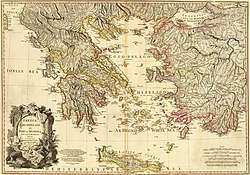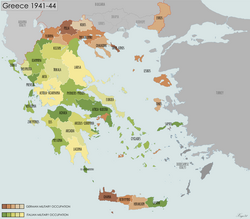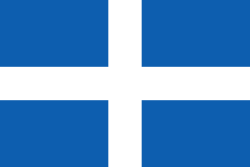Hellenic State (1941–1944)
This article needs additional citations for verification. (May 2022) |
Hellenic State Ἑλληνική Πολιτεία Elliniki Politeia | |||||||||
|---|---|---|---|---|---|---|---|---|---|
| 1941–1944 | |||||||||
Coat of arms[1]
| |||||||||
| Motto: " Collaborationist under Axis powers (1941–43) | |||||||||
| Plenipotentiary | |||||||||
• 1941–1943 | Günther Altenburg | ||||||||
• 1943–1944 | Hermann Neubacher | ||||||||
| Prime Minister | |||||||||
• 1941–1942 | Georgios Tsolakoglou | ||||||||
• 1942–1943 | Konstantinos Logothetopoulos | ||||||||
• 1943–1944 | Ioannis Rallis | ||||||||
| Historical era | German withdrawal | 12 October 1944 | |||||||
| Currency | Greek drachma (₯) | ||||||||
| |||||||||
| Today part of | |||||||||
| History of Greece |
|---|
 |
|
|
The Hellenic State (
History
Establishment

After the
Government and politics
The regime was first led by
Administrative divisions
Administratively, the Hellenic State was divided into a number of prefectures.


Decline and fall
The Hellenic State lacked the infrastructure and latitude for action to face the great difficulties of the Occupation period; it was also devoid of any political legitimacy, and was widely considered a puppet government. Tsolakoglou demanded greater political rights for his government, and soon threatened to resign.[3] The proclamation of a mandatory work service in Germany for Greek citizens proved widely unpopular and hastened the fall of Tsolakoglou; on 17 November 1942, he was sacked and replaced by his deputy, Konstantinos Logothetopoulos. The new government announced that 80,000 Greek citizens were to be sent to Germany. This led to widespread demonstrations and strikes, and the decision was eventually revoked.[citation needed] Logothetopoulos, who had protested against the measures taken by the Axis occupation authorities, was himself sacked on 6 April 1943. Against the wishes of the Italians, who favored Finance Minister Sotirios Gotzamanis, he was replaced by Ioannis Rallis, a monarchist politician. Rallis, who was looking beyond the German withdrawal from Greece to the restoration of the post-war political order, and who was alarmed by the growth of the mostly Communist-dominated Greek resistance, obtained German consent for the creation of the Security Battalions, armed formations that were used in anti-partisan offensives.
Military
The collaborationist regime under Rallis set up
Exile and trial
In September 1944, a new collaborationist government was established at
References
- ^ Hubert de Vries (2017). "HELLAS". heraldica civica et militara De Rode Leeuw een site over heraldiek en verwante onderwerpen Hubert de Vries. Archived from the original on 2023-06-29. Retrieved 2023-10-13.
- ISBN 978-3-11-067108-7.
- ^ a b Bernhard R. Kroener, Germany and the Second World War Volume V/II, Oxford University Press, 2003, p. 44
- ^ Markos Vallianatos, The untold history of Greek collaboration with Nazi Germany (1941–1944)
- ^ Οι Τσιρονίκος και Ταβουλάρης συνελήφθησαν, Εφημερίδα «Ελευθερία», Παρασκευή 11 Μαΐου 1945, σελίδα 2.
- ^ Ο Τσιρονίκος παρεδόθη χθες εις τας Ελληνικάς Αρχάς, Εφημερίδα «Εμπρός», Τρίτη 27 Αυγούστου 1946, σελίδα 5.
- ^ Ο Ε.Τσιρονίκος υπέβαλε αίτηση χάριτος, Εφημερίδα «Εμπρός», Τρίτη 27 Αυγούστου 1946, σελίδα 5.
- ^ Charles R. Schrader, The withered vine: logistics and the communist insurgency in Greece, 1945–1949, Greenwood Press, 1999, p. 38
External links


![Coat of arms[1] of Hellenic State (1941–1944)](http://upload.wikimedia.org/wikipedia/commons/thumb/5/5b/Coat_of_arms_of_Greece_%281924%E2%80%931935%29.svg/120px-Coat_of_arms_of_Greece_%281924%E2%80%931935%29.svg.png)